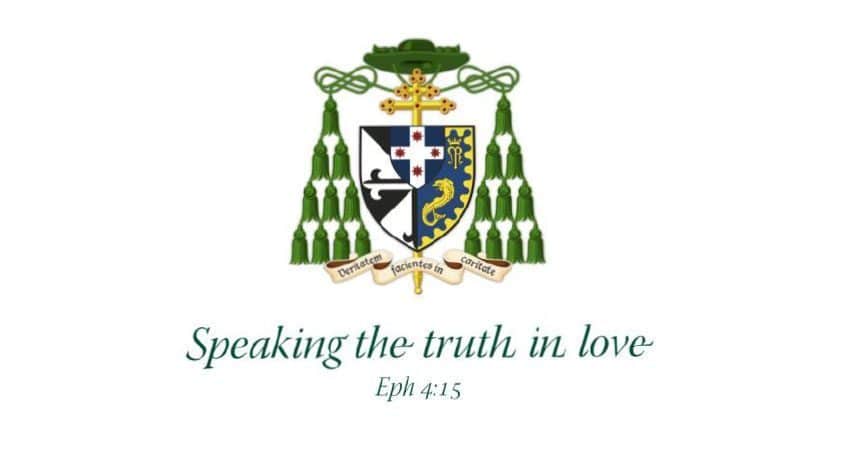Homily for Anniversary Mass of Dedication

In November 1928 Donald Bradman made his test debut for Australia, batting in the middle order and scoring only 18 and 1 as his team lost to England by a spectacular 675 runs, a result even more lop-sided than this year’s Ashes series. Little did the world guess what he would go on to do: score almost 7,000 test runs at an average of a century per innings in 52 tests, numbers that are etched not just in cricket folklore but in the Australian national consciousness. So significant was Bradman to Australia’s psyche during the Great Depression and World War II that some would say that to write a biography of Bradman is to write a biography of Australians in that period.[1]
A couple of months beforehand another grand and somewhat unexpected career began of some significance for Australia: that of St Mary’s Cathedral. On 2 September 1928 Archbishop Michael Kelly dedicated the new St Mary’s after the nave had finally been finished. Of course, there had been previous dedications in the long and tortuous history of our nation’s mother church, each of which marking another Archbishop and another chapter in the life of Sydney and its people.
Fr John Joseph Therry first obtained the grant of land and raised funds for the building of the old St Mary’s Chapel, the foundation stone of which was laid by Governor Lachlan Macquarie in 1821. That church automatically became our cathedral on the arrival of our first Archbishop, John Bede Polding, in 1835 and it was modified in the “Gothic Revival” style according to designs by Augustus Welby Pugin.
Soon after Therry’s death the first cathedral was burnt down (1865) and planning and fund-raising began for a new Cathedral in that same neogothic style but much grander. Pugin’s friend William Wardell was appointed as the architect, planning and fundraising began, and a new foundation stone was laid in 1868. By 1882 there was enough of a cathedral completed to allow Archbishop Roger Vaughan to dedicate it liturgically and open it for use by the faithful. By 1900 the central tower had been completed and the cathedral at last debt-free, so the third Archbishop, Cardinal Patrick Moran formally consecrated it. But there was still much to do and in 1913 Archbishop Michael Kelly laid the foundation stone for the new nave.
It was on this day, in 1928, that Kelly dedicated that nave, just in time for the commencement of the 29th International Eucharistic Congress. The slight difference of colour and texture of the sandstone on the internal walls marks the division between the first and second stages. Of course there was still more to be done. The decoration and enrichment of the cathedral continued with the remains of Archbishop Vaughan being returned to Sydney and buried within the Chapel of the Irish Saints. The richly decorated crypt which enshrines the bodies of many of the early priests and bishops was not completed until 1961 when it was dedicated by Cardinal Norman Thomas Gilroy. With assistance from government and industry, the Catholic community crowned its achievement here with the spires built in the millennium year under Cardinal Edward Clancy.
Every generation makes its contribution and so under Cardinal George Pell much work was done on restoring the external stone, the floors and the sanctuary. The Cathedral was a focus for the World Youth Day celebrations in 2008, including Pope Benedict consecrating the new permanent altar and blessing the much-loved painting of Our Lady of the Southern Cross. Only this year I had the privilege to bless a new nineteenth century French Gothic sanctuary lamp and statues of women saints in the Lady Chapel reredos. So this grand old lady that is our cathedral continues her progress in our city, adorned anew by each generation and ensuring that in the heart of our city is a place of beauty, prayer and pilgrimage for Catholics and visitors alike.
Why do we Catholics set such store by church buildings and generation after generation seek to improve them? Why is today so significant that it is a liturgical Solemnity in the Cathedral and a Feast in all the other churches of the Archdiocese?
There are many reasons. One is the very human one: that a cathedral like ours stands out. It is so high it can be seen from many angles in our city, so beautiful that it delights every eye when it comes into view, so long that it’s length is marked in the nave of St Peter’s in Rome, so grand that tourists express surprise such things can be found in Australia. (Indeed, one inquired whether it had been built in the Middle Ages and how many centuries it took…). It is a landmark in our city, like the Opera House and Harbour Bridge, a place of civic celebrations and memorials, a place of very real social significance.
Yet for all the wow achieved by its architects and decorators, the Cathedral is first and foremost for the worship of God, a God our first reading points out cannot be contained in the entire cosmos, let alone a church building (1Kgs 8:22-30). So the second meaning of our Church is its liturgical one: here babies are reborn by water and the Holy Spirit, sins are absolved, the Word proclaimed, the Holy Sacrifice celebrated, and we commune in that Eucharist and adore it in our daily prayer.
What’s more, churches point to Christ as the Living Temple in whom the fullness of divinity dwells bodily, the portal between heaven and earth (Jn 14:6, Col 2:9; 1Tim 1:17). In our Gospel today, Peter identifies Him as the Son of the Living God who will found that True Church which our earthly buildings only palely signify; Jesus in turn names him as Rock, intimating that there will be more foundations and buildings to come. But in those buildings it will be that same Christ we come to hear and receive, the Divine Word sung by the Father from all eternity.
And if we come to churches like St Mary’s to commune with Christ, we do so with all the others also communing here and elsewhere with Him (cf. 1Cor 3:9-17; 12:12-13). We are joined through the Church with 2½ billion Christian brothers and sisters in the world today; but also with Christians from earliest times emerging from the catacombs to build the great basilicas of Rome, or from colonial times emerging from the barracks to build the first great basilica in this land; delighting in a new sacred culture in the mediaeval period or the construction of a neo-gothic imitation a millennium later at the other side of the world; decorating their chapels with mementos of saints and sinners from their cities or ours, of Sydney yesterday and today and in days yet to come.
All this points beyond our past and present to our future: our actions here and now express our hope for eternal life and prepare us for that time when we will join our Lord and all those generations entombed or remembered here in the New Jerusalem (Rev 22:1-3; Benedict XVI, Spe Salvi 12). So, you might say if you liked big words, that churches are not merely social and liturgical, but Christological, ecclesiological and eschatological: they point to something greater and more eternal than our everyday domestic, commercial and leisure concerns. And it is for that something greater that we must all be sandstone blocks and stained glass windows by which Sydney may glimpse Christ and find communion with Him for ever. Happy feast day!
[1] Cited in http://www.espncricinfo.com/magazine/content/story/469905.html

